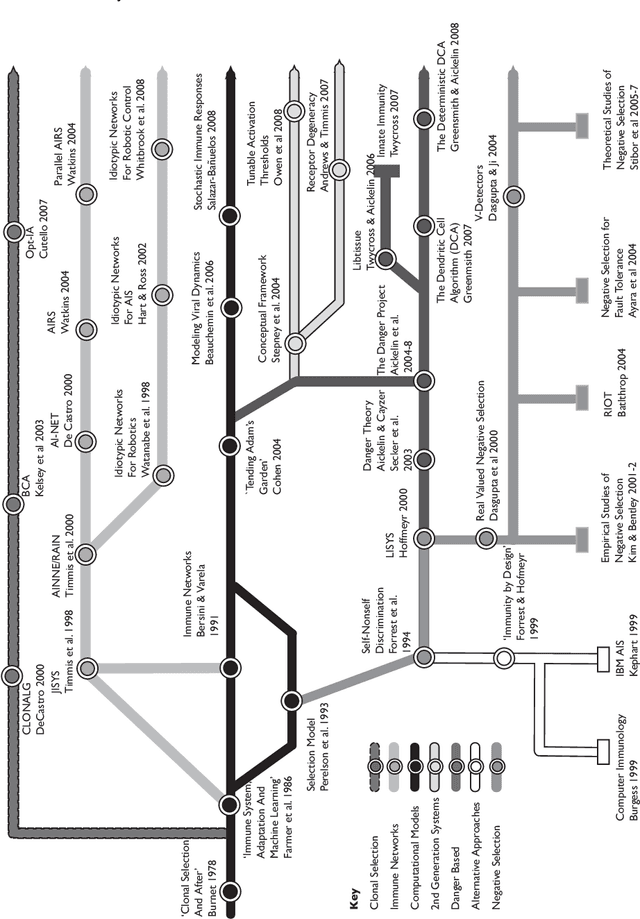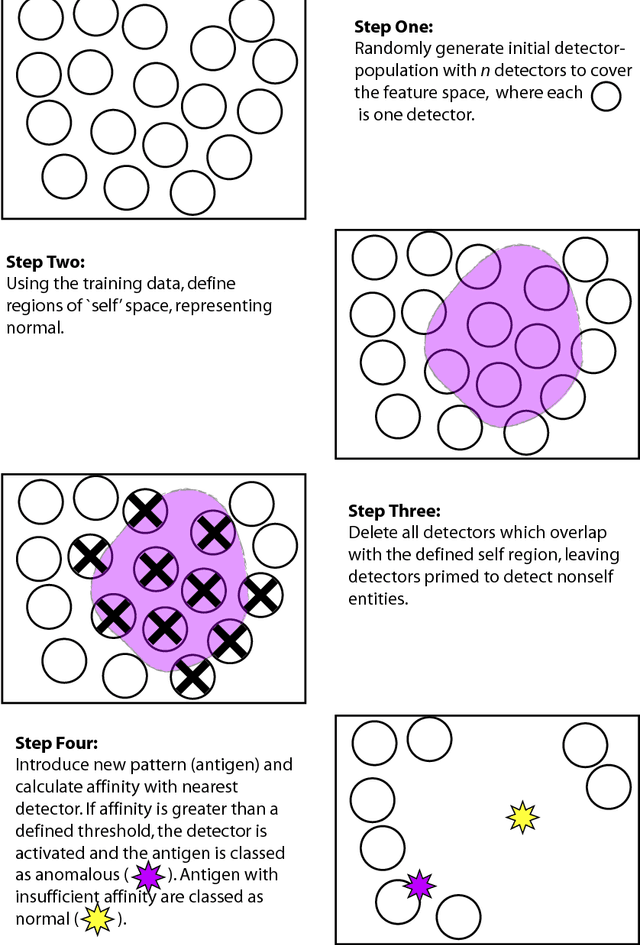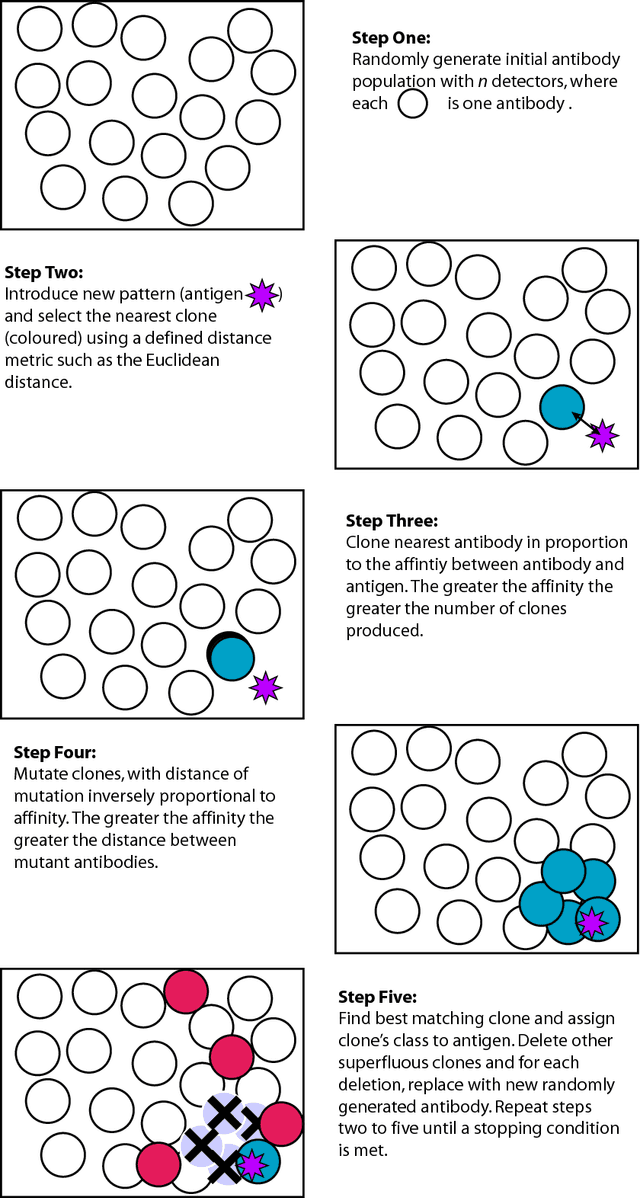Julie Greensmith
Quiet in Class: Classification, Noise and the Dendritic Cell Algorithm
Jul 04, 2013

Abstract:Theoretical analyses of the Dendritic Cell Algorithm (DCA) have yielded several criticisms about its underlying structure and operation. As a result, several alterations and fixes have been suggested in the literature to correct for these findings. A contribution of this work is to investigate the effects of replacing the classification stage of the DCA (which is known to be flawed) with a traditional machine learning technique. This work goes on to question the merits of those unique properties of the DCA that are yet to be thoroughly analysed. If none of these properties can be found to have a benefit over traditional approaches, then "fixing" the DCA is arguably less efficient than simply creating a new algorithm. This work examines the dynamic filtering property of the DCA and questions the utility of this unique feature for the anomaly detection problem. It is found that this feature, while advantageous for noisy, time-ordered classification, is not as useful as a traditional static filter for processing a synthetic dataset. It is concluded that there are still unique features of the DCA left to investigate. Areas that may be of benefit to the Artificial Immune Systems community are suggested.
Theoretical formulation and analysis of the deterministic dendritic cell algorithm
May 31, 2013



Abstract:As one of the emerging algorithms in the field of Artificial Immune Systems (AIS), the Dendritic Cell Algorithm (DCA) has been successfully applied to a number of challenging real-world problems. However, one criticism is the lack of a formal definition, which could result in ambiguity for understanding the algorithm. Moreover, previous investigations have mainly focused on its empirical aspects. Therefore, it is necessary to provide a formal definition of the algorithm, as well as to perform runtime analyses to revealits theoretical aspects. In this paper, we define the deterministic version of the DCA, named the dDCA, using set theory and mathematical functions. Runtime analyses of the standard algorithm and the one with additional segmentation are performed. Our analysis suggests that the standard dDCA has a runtime complexity of O(n2) for the worst-case scenario, where n is the number of input data instances. The introduction of segmentation changes the algorithm's worst case runtime complexity to O(max(nN; nz)), for DC population size N with size of each segment z. Finally, two runtime variables of the algorithm are formulated based on the input data, to understand its runtime behaviour as guidelines for further development.
The Dendritic Cell Algorithm for Intrusion Detection
May 31, 2013



Abstract:As one of the solutions to intrusion detection problems, Artificial Immune Systems (AIS) have shown their advantages. Unlike genetic algorithms, there is no one archetypal AIS, instead there are four major paradigms. Among them, the Dendritic Cell Algorithm (DCA) has produced promising results in various applications. The aim of this chapter is to demonstrate the potential for the DCA as a suitable candidate for intrusion detection problems. We review some of the commonly used AIS paradigms for intrusion detection problems and demonstrate the advantages of one particular algorithm, the DCA. In order to clearly describe the algorithm, the background to its development and a formal definition are given. In addition, improvements to the original DCA are presented and their implications are discussed, including previous work done on an online analysis component with segmentation and ongoing work on automated data preprocessing. Based on preliminary results, both improvements appear to be promising for online anomaly-based intrusion detection.
Immune System Approaches to Intrusion Detection - A Review (ICARIS)
May 30, 2013
Abstract:The use of artificial immune systems in intrusion detection is an appealing concept for two reasons. Firstly, the human immune system provides the human body with a high level of protection from invading pathogens, in a robust, self-organised and distributed manner. Secondly, current techniques used in computer security are not able to cope with the dynamic and increasingly complex nature of computer systems and their security. It is hoped that biologically inspired approaches in this area, including the use of immune-based systems will be able to meet this challenge. Here we collate the algorithms used, the development of the systems and the outcome of their implementation. It provides an introduction and review of the key developments within this field, in addition to making suggestions for future research.
Detecting Danger: The Dendritic Cell Algorithm
Jun 25, 2010



Abstract:The Dendritic Cell Algorithm (DCA) is inspired by the function of the dendritic cells of the human immune system. In nature, dendritic cells are the intrusion detection agents of the human body, policing the tissue and organs for potential invaders in the form of pathogens. In this research, and abstract model of DC behaviour is developed and subsequently used to form an algorithm, the DCA. The abstraction process was facilitated through close collaboration with laboratory- based immunologists, who performed bespoke experiments, the results of which are used as an integral part of this algorithm. The DCA is a population based algorithm, with each agent in the system represented as an 'artificial DC'. Each DC has the ability to combine multiple data streams and can add context to data suspected as anomalous. In this chapter the abstraction process and details of the resultant algorithm are given. The algorithm is applied to numerous intrusion detection problems in computer security including the detection of port scans and botnets, where it has produced impressive results with relatively low rates of false positives.
* 27 pages, 8 figures, Robust Intelligent Systems
Artificial Immune Systems
Jun 25, 2010


Abstract:The human immune system has numerous properties that make it ripe for exploitation in the computational domain, such as robustness and fault tolerance, and many different algorithms, collectively termed Artificial Immune Systems (AIS), have been inspired by it. Two generations of AIS are currently in use, with the first generation relying on simplified immune models and the second generation utilising interdisciplinary collaboration to develop a deeper understanding of the immune system and hence produce more complex models. Both generations of algorithms have been successfully applied to a variety of problems, including anomaly detection, pattern recognition, optimisation and robotics. In this chapter an overview of AIS is presented, its evolution is discussed, and it is shown that the diversification of the field is linked to the diversity of the immune system itself, leading to a number of algorithms as opposed to one archetypal system. Two case studies are also presented to help provide insight into the mechanisms of AIS; these are the idiotypic network approach and the Dendritic Cell Algorithm.
The DCA:SOMe Comparison A comparative study between two biologically-inspired algorithms
Jun 08, 2010



Abstract:The Dendritic Cell Algorithm (DCA) is an immune-inspired algorithm, developed for the purpose of anomaly detection. The algorithm performs multi-sensor data fusion and correlation which results in a 'context aware' detection system. Previous applications of the DCA have included the detection of potentially malicious port scanning activity, where it has produced high rates of true positives and low rates of false positives. In this work we aim to compare the performance of the DCA and of a Self-Organizing Map (SOM) when applied to the detection of SYN port scans, through experimental analysis. A SOM is an ideal candidate for comparison as it shares similarities with the DCA in terms of the data fusion method employed. It is shown that the results of the two systems are comparable, and both produce false positives for the same processes. This shows that the DCA can produce anomaly detection results to the same standard as an established technique.
* 38 pages, 29 figures, 10 tables, Evolutionary Intelligence
The Deterministic Dendritic Cell Algorithm
Jun 08, 2010


Abstract:The Dendritic Cell Algorithm is an immune-inspired algorithm orig- inally based on the function of natural dendritic cells. The original instantiation of the algorithm is a highly stochastic algorithm. While the performance of the algorithm is good when applied to large real-time datasets, it is difficult to anal- yse due to the number of random-based elements. In this paper a deterministic version of the algorithm is proposed, implemented and tested using a port scan dataset to provide a controllable system. This version consists of a controllable amount of parameters, which are experimented with in this paper. In addition the effects are examined of the use of time windows and variation on the number of cells, both which are shown to influence the algorithm. Finally a novel metric for the assessment of the algorithms output is introduced and proves to be a more sensitive metric than the metric used with the original Dendritic Cell Algorithm.
* 12 pages, 1 algorithm, 1 figure, 2 tables, 7th International Conference on Artificial Immune Systems (ICARIS 2008)
The Application of a Dendritic Cell Algorithm to a Robotic Classifier
Apr 29, 2010



Abstract:The dendritic cell algorithm is an immune-inspired technique for processing time-dependant data. Here we propose it as a possible solution for a robotic classification problem. The dendritic cell algorithm is implemented on a real robot and an investigation is performed into the effects of varying the migration threshold median for the cell population. The algorithm performs well on a classification task with very little tuning. Ways of extending the implementation to allow it to be used as a classifier within the field of robotic security are suggested.
* 12 pages, 4 figures, Proceedings of the 6th International Conference on Artificial Immune Systems (ICARIS2007)
Performance Evaluation of DCA and SRC on a Single Bot Detection
Apr 22, 2010



Abstract:Malicious users try to compromise systems using new techniques. One of the recent techniques used by the attacker is to perform complex distributed attacks such as denial of service and to obtain sensitive data such as password information. These compromised machines are said to be infected with malicious software termed a "bot". In this paper, we investigate the correlation of behavioural attributes such as keylogging and packet flooding behaviour to detect the existence of a single bot on a compromised machine by applying (1) Spearman's rank correlation (SRC) algorithm and (2) the Dendritic Cell Algorithm (DCA). We also compare the output results generated from these two methods to the detection of a single bot. The results show that the DCA has a better performance in detecting malicious activities.
* 11 pages, 4 figures, 6 tables, Journal of Information Assurance and Security
 Add to Chrome
Add to Chrome Add to Firefox
Add to Firefox Add to Edge
Add to Edge